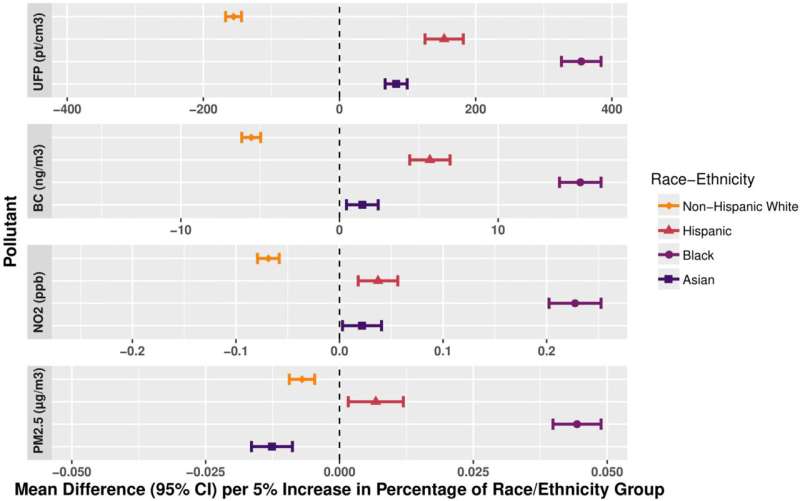This article has been reviewed according to Science X's editorial process and policies. Editors have highlighted the following attributes while ensuring the content's credibility:
fact-checked
peer-reviewed publication
trusted source
proofread
Research shows ultrafine air pollution reflects Seattle's redlining history

Despite their invisibly small size, ultrafine particles have become a massive concern for air pollution experts. These tiny pollutants—typically spread through wildfire smoke, vehicle exhaust, industrial emissions and airplane fumes—can bypass some of the body's built-in defenses, carrying toxins to every organ or burrowing deep in the lungs.
New research from the University of Washington found that those effects aren't felt equitably in Seattle. The most comprehensive study yet of long-term ultrafine particle exposure found that concentrations of this tiny pollutant reflect the city's decades-old racial and economic divides.
The study, published in Environmental Health Perspectives, also found that racial and socioeconomic disparities in ultrafine particle exposure are larger than those observed in more commonly studied pollutants, like fine particles (PM 2.5) and nitrogen dioxide (NO2).
The study used mobile monitoring—a car loaded with air pollution sensors driving around the city for the better part of a year—to examine long-term average levels of four pollutants: soot (or black carbon), fine particles (PM 2.5), nitrogen dioxide (NO2) and ultrafine particles. Researchers found the highest concentrations of all four pollutants on census blocks with median household incomes under $20,000 and those with proportionately larger Black populations.
Disparities in concentrations of ultrafine particles—which are less than 0.1 micron in diameter, or 700 times thinner than the width of a single human hair—were especially stark. Blocks with median incomes under $20,000 had long-term UFP concentrations 40% higher than average. Blocks where median incomes are over $110,000, meanwhile, saw UFP concentrations 16% lower than average.
"We found greater disparities with this pollutant of emerging interest, a pollutant that hasn't been well-characterized. That's very interesting," said senior author Lianne Sheppard, a UW professor in the Department of Environmental and Occupational Health Sciences. "Our work has shown the highest ultrafine particle concentrations are north of the airport and below common aircraft landing paths, downtown, and south of downtown where there are port and other industrial activities."
The study also found that modern-day air pollution disparities mirror Seattle's history of redlining, the racist practice that denied racial minorities and low-income residents access to bank loans, homeownership and other wealth-building opportunities in more "desirable" areas. The practice shaped American cities throughout the early 20th century, building a foundation of segregation and environmental racism.
Today, neighborhoods once classified as "hazardous" are still exposed to higher concentrations of pollution than those once labeled "desirable," the study found. This was true for all sizes of particles. The spatial disparities were largest, however, in Seattle neighborhoods that received no label because they were once considered industrial areas.
In those previously industrial areas, ultrafine particle concentrations were 49% above average.
"These results are important because air pollution exposure has been shown to lead to detrimental health effects, and these health effects disproportionately impact racialized and low-income communities," said Kaya Bramble, the study's lead author, who graduated from the UW in 2022 with a degree in industrial and systems engineering. "Notably, air pollution is just one factor, and there are plenty of other examples of how systemic racism is detrimental to people's health and well-being."
Bramble said the results didn't surprise her. She was raised in Tacoma, in a neighborhood near Interstate 5, where the constant crush of cars and diesel trucks spewed pollution into the air. And as a student journalist at the UW, she researched the relationship between redlining, green spaces, heat and air pollution.
"In the case of air pollution exposures, these policies affect the health of real people. I think at a time where the teaching of systemic racism is a controversial topic in this country, being ignorant is not going to reduce the number of children who suffer from asthma due to air pollution," Bramble said. "Instead, I hope we can have conversations about how past policies affect us today, to drive efforts toward a healthier, sustainable society."
More information: Kaya Bramble et al, Exposure Disparities by Income, Race and Ethnicity, and Historic Redlining Grade in the Greater Seattle Area for Ultrafine Particles and Other Air Pollutants, Environmental Health Perspectives (2023). DOI: 10.1289/EHP11662
Journal information: Environmental Health Perspectives
Provided by University of Washington




















